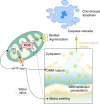The impact of mitochondrial dysfunction on osteoarthritis cartilage: current insights and emerging mitochondria-targeted therapies
- PMID: 40887466
- PMCID: PMC12399774
- DOI: 10.1038/s41413-025-00460-x
The impact of mitochondrial dysfunction on osteoarthritis cartilage: current insights and emerging mitochondria-targeted therapies
Abstract
Osteoarthritis (OA) is a degenerative joint disease associated with age, prominently marked by articular cartilage degradation. In OA cartilage, the pathological manifestations show elevated chondrocyte hypertrophy and apoptosis. The mitochondrion serves as key energy supporter in eukaryotic cells and is tightly linked to a myriad of diseases including OA. As age advances, mitochondrial function declines progressively, which leads to an imbalance in chondrocyte energy homeostasis, partially initiating the process of cartilage degeneration. Elevated oxidative stress, impaired mitophagy and mitochondrial dynamics jointly contribute to chondrocyte pathology, with mitochondrial DNA haplogroups, particularly haplogroup J, influencing OA progression. Therapeutic approaches directed at mitochondria have demonstrated remarkable efficacy in treating various diseases, with triphenylphosphonium (TPP) emerging as the most widely utilized molecule. Other strategies encompass Dequalinium (DQA), the Szeto-Schiller (SS) tetrapeptide family, the KLA peptide, and mitochondrial-penetrating peptides (MPP), etc. These molecules share common properties of lipophilicity and positive charge. Through various technological modifications, they are conjugated to nanocarriers, enabling targeted drug delivery to mitochondria. Therapeutic interventions targeting mitochondria offer a hopeful direction for OA treatment. In the future, mitochondria-targeted therapy is anticipated to improve the well-being of life for the majority of OA patients. This review summarizes the link between chondrocyte mitochondrial dysfunction and OA, as well as discusses promising mitochondria-targeted therapies and potential therapeutic compounds.
© 2025. The Author(s).
Conflict of interest statement
Competing interests: The authors declare no competing interests.
Figures




Similar articles
-
Phenotypic screening identified polydatin alleviating cartilage degeneration by modulating SIRT3-dependent mitochondrial dysfunction.Phytomedicine. 2025 Aug;144:156948. doi: 10.1016/j.phymed.2025.156948. Epub 2025 Jun 3. Phytomedicine. 2025. PMID: 40505483
-
Proteolysis of the pericellular matrix: Pinpointing the role and involvement of matrix metalloproteinases in early osteoarthritic remodeling.Acta Biomater. 2024 Jun;181:297-307. doi: 10.1016/j.actbio.2024.05.002. Epub 2024 May 6. Acta Biomater. 2024. PMID: 38710401
-
[Research progress on the role of chondrocyte mitochondrial homeostasis imbalance in the pathogenesis of osteoarthritis].Zhongguo Xiu Fu Chong Jian Wai Ke Za Zhi. 2023 Jun 15;37(6):748-757. doi: 10.7507/1002-1892.202303006. Zhongguo Xiu Fu Chong Jian Wai Ke Za Zhi. 2023. PMID: 37331955 Free PMC article. Chinese.
-
The role of autophagy in mitigating osteoarthritis progression via regulation of chondrocyte apoptosis: A review.Joint Bone Spine. 2024 May;91(3):105642. doi: 10.1016/j.jbspin.2023.105642. Epub 2023 Sep 20. Joint Bone Spine. 2024. PMID: 37739213 Review.
-
Osteoarthritis in cats: what we know, and mostly, what we don't know. . . yet.J Feline Med Surg. 2025 Jul;27(7):1098612X251347999. doi: 10.1177/1098612X251347999. Epub 2025 Jul 20. J Feline Med Surg. 2025. PMID: 40685570 Free PMC article. Review.
References
-
- Martel-Pelletier, J. et al. Osteoarthritis. Nat. Rev. Dis. Prim.2, 16072 (2016). - PubMed
-
- Oliveria, S. A., Felson, D. T., Reed, J. I., Cirillo, P. A. & Walker, A. M. Incidence of symptomatic hand, hip, and knee osteoarthritis among patients in a health maintenance organization. Arthritis Rheum.38, 1134–1141 (1995). - PubMed
-
- Sellam, J. & Berenbaum, F. Is osteoarthritis a metabolic disease?. Jt. Bone Spine80, 568–573 (2013). - PubMed
Publication types
MeSH terms
Grants and funding
LinkOut - more resources
Full Text Sources
Medical
Research Materials

